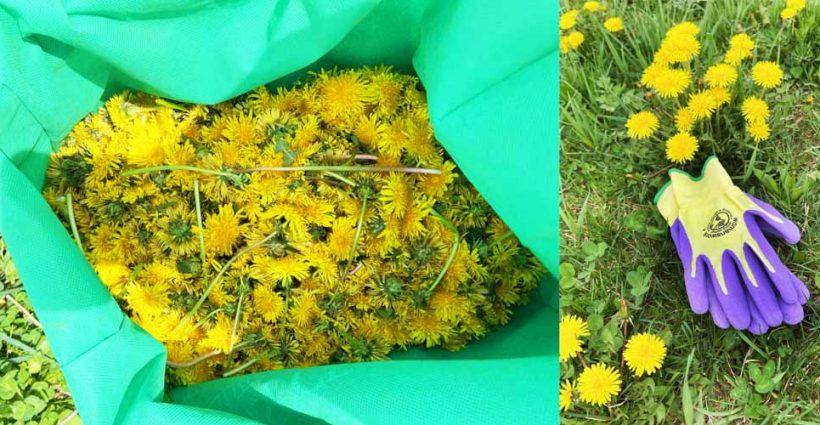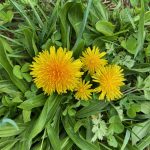designed for the way women work.

Turning Dandelions Into Wine Starts With the Picking, By Jeannette Ross
Category: Presenting "The Curious Gardener"
Dandelions are highly unappreciated. Lovers of emerald-green lawns may have them in their cross-hairs, but these golden pops of color provide spring nectar to bees, greens for your salad, and more.
The more? They are the main ingredient in a delightful dandelion wine called Memento-Mori produced by Enlightenment Wines of Brooklyn, N.Y. Recently I joined about two dozen others for an afternoon of dandelion foraging at Fishkill Farms in Fishkill, N.Y.
Picking dandelions is pretty straightforward, as one might imagine, but there are a few rules. Open, yellow dandelions, with some stem attached, were the main object of our hunt. Closed dandelions that are still yellow are OK, too. No white dandelions are allowed.
Armed with my Womanswork latex weeders, I set out picking. The first hour goes by pretty quickly. I was in an area with lots of dandelions so I could kneel as I picked with both hands, tossing my bounty into a woven shopping bag. Breathable bags prevent the flowers from degrading.
Every hour or so, Harris Shper, the mazer – as a mead maker is called – came by to collect what we picked. He weighed each bag and brought them back to the orchard’s cooler where they stayed until he packed them up for the return to Brooklyn, about 90 minutes away.
Some harvesters wore headphones, others chatted in groups. One woman told me she found the process “addicting.” I found myself contemplating the different sizes and fullness of dandelions. As I began to get a little achy I began searching out taller flowers, as they were easier to pick. I moved on to the rows of the orchard, where I foraged under a profusion of apple blossoms.
Over the course of about four hours, I picked about eight pounds of dandelions. As a group we harvested 250 pounds, that will be turned into 2,500 bottles of wine ready for sale next year.
The wine is actually mead, which is fermented with honey, wildflowers, herbs and natural yeast. Memento-Mori is made with dandelions, honey, yeast, water and orange peels. Another mead Enlightenment Wines produces, called Night Eyes, is made with sumac that has also been harvested at the orchard.
Harris said when the dandelions got back to the winery he would use about half to make a tea, to which honey is added. The honey is sourced from an apiary called Tremblay, in the Finger Lakes region of New York State.
The tea ferments slowly for about a month or two, and then is transferred to barrels where it remains for a year. More dandelions are then added to soak, after which the wine is bottled. A little extra honey is added at this point for a touch of sweetness. There is no distilling to the process, he pointed out.
The finished product, according to the winery, creates a “sensory experience akin to strolling in a meadow on the first warm day of spring.”
Mead will be familiar to fans of Game of Thrones or Renaissance fairs, but its history well predates the Middle Ages. According to Encyclopedia Britannica, mead was made as early as the 7th century BC in China. Mead has also been drunk in India, Africa and throughout Asia, as well as Greece, Scandinavia, Gaul and what is now Great Britain.
While the popularity of mead lost ground to wine, beer and ale, it is making a comeback. According to the American Mead Makers Association, there are about 450 meaderies, wineries and breweries that offer at least one type of mead.
As for dandelions, they are not native to North America, but are believed to have been brought here by early settlers – perhaps even on the Mayflower – prized for their medicinal attributes. They have substantial amounts of vitamins A and C, as well as iron, potassium, and calcium.
Adventurous souls may wish to try making mead at home, but I will stick with the kind I can buy in a store.
“The ethos is to have people drink wine with local ingredients, the flora right around them,” Harris said. “You don’t need a vineyard to enjoy the berries and fruits.
“We try to get people excited about it, knowing they had a part in making the wine.”
You can be sure I will buy a bottle next year, knowing my efforts – and “my” dandelions – went into it.



How interesting, I had no idea a dandelion harvest was happening in nearby Fishkill, and for the purpose of making mead! I’m going to look for Enlightenment Wines at a local wine shop.
Dandelions are a beneficial plant, which I welcome in my garden. Their roots loosen compressed soil and bring up deep nutrients to the surface. Added to the compost pile before they go to seed, they will release their minerals as they break down.